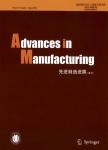Investigation into the room temperature creep-deformation of potassium dihydrogen phosphate crystals using nanoindentation
作者机构:School of Mechatronics Engineering The Harbin Institute of Technology Harbin 150001 People's Republic of China Ministry of Education Key Laboratory of Micro-systems and Micro-structures Manufacturing The Harbin Institute of Technology Harbin 150001 People's Republic of China Laboratory for Precision and Nano Processing Tech no logies. School of Mechanical and Manufacturing Engineering The University of New South Wales Sydney NSW 2052 Australia
出 版 物:《Advances in Manufacturing》 (先进制造进展(英文版))
年 卷 期:2018年第6卷第4期
页 面:376-383页
核心收录:
基 金:National Nature Science Foundation of China (Grant Nos. 51875137 and 51375122) Heilongjiang Natural Science Foundation (Grant No. E2018033) Australian Research Council (Grant No. DP 170100567)
主 题:Potassium dihydrogen phosphate (KDP) crystals Creep-deformation Stress Dislocation
摘 要:It has been a tremendous challenge to manu facture damage-free and smooth surfaces of potassium dihydrogen phosphate (KDP) crystals to meet the require ments of high-energy laser systems. The intrinsic issue is whether a KDP crystal can be plastically deformed so that the material can be removed in a ductile mode during the machining of KDP. This study investigates the room tem perature creep-deformation of KDP crystals with the aid of nanoindentation. A stress analysis was carried out to identify the creep mechanism. The results showed that KDP crystals could be plastically deformed at the nanoscale. Dislocation motion is responsible for creep-deformation. Both creep rate and creep depth decrease with decrease in peak force and loading rate. Dislocation nucleation and propagation bring about pop-ins in the load displacement curves during nanoindentation.



